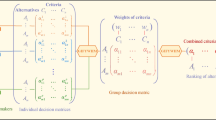Abstract
The main purpose of this paper is to propose a data mining algorithm for finding interesting association rules from given sets of fuzzy transaction data. To efficiently resolve the ambiguity frequently arising in available information and do more justice to the essential fuzziness in human judgment and preference, the trapezoidal fuzzy numbers are used to describe the fuzzy assessments of transaction data. Then, combining the concepts of fuzzy set theory and the priori algorithms, the interesting item sets are found to construct the association rules. Finally, a numerical example is used to demonstrate the computational process of proposed data mining algorithm. By utilizing this data mining algorithm, the decision-makers’ fuzzy assessments with various rating attitudes can be taken into account in the data mining process to assure more convincing and accurate knowledge discovery.

Similar content being viewed by others
References
Agrawai, R., Srikant, R.: Fast algoritjm for mining association rules. In: Proceedings of the International Conference on Very Large Data Bases, pp. 487–499 (1994)
Chen, S.H., Hsieh, C.H.: A model and algorithm of fuzzy product positioning. Inf. Sci. 121, 61–82 (1999)
Chen, S.H., Hsieh, C.H.: Representation, ranking, distance, and similarity of L-R type fuzzy number and application. Aust. J. Intell. Process. Syst. 6(4), 217–229 (2000)
Deng, Y., Shi, W.K.: A modified aggregation of fuzzy opinions under group decision making. Cybern. Syst. Int. J. 34, 207–217 (2003)
Dick, A., Meeks, A., Last, M., Bunke, H., Kandel, A.: Data mining in software metrics databases. Fuzzy Sets Syst. 145, 81–100 (2004)
Dubois, D., Prade, H.: Operations on fuzzy numbers. Int. J. Syst. Sci. 9, 613–626 (1978)
Editorial, data mining for financial decision making. Decis. Support Syst. 37, 457–460 (2004)
Etik, N., Allahverdi, N., Sert, I.U., Saritas, I.: Fuzzy expert system design for operating room air-condition control systems. Expert Syst. Appl. 36(6), 9752–9758 (2009)
Heilpern, S.: Representation and application of fuzzy numbers. Fuzzy Sets Syst. 91(2), 259–268 (1997)
Heinrichs, J.H., Lim, J.S.: Integrating web-based data mining tools for knowledge management. Decis. Support Syst. 35, 103–112 (2003)
Hong, T.P., Kuo, C.S., Chi, S.C.: A data mining algorithm for transaction data with quantitative values. Intell. Data Anal. 3(5), 363–376 (1999)
Hsu, H.M., Chen, C.T.: Aggregating of fuzzy opinions under group making. Fuzzy Sets Syst. 79(3), 279–285 (1996)
Hu, Y.C., Tzeng, G.H.: Elicitation of classification rules by fuzzy data mining. Eng. Appl. Artif. Intell. 16, 709–716 (2003)
Hüllermeier, E.: Fuzzy methods in machine learning and data mining: status and prospects. Fuzzy Sets Syst. 156, 387–406 (2005)
Kaufmann, A., Gupta, M.M.: Introduction to Fuzzy Arithmetic Theory and Application. Van Nostrand Reinhold, New York (1991)
Kim, Y.S., Street, W.N.: An intelligent system for customer targeting: a data mining approach. Decis. Support Syst. 37, 215–228 (2004)
Lee, H.S.: Aggregation of fuzzy opinions under group decision making environment. In: Proceedings of the 10th IEEE International Conference on Fuzzy Systems, vol. 1., pp. 172–175. Melbourne, Australia, 2–5 Dec 2001
Liang, G.S., Wang, M.J.: Benefit/cost analysis using fuzzy concept. Eng. Econ. 40(4), 359–376 (1995)
Maimon, O., Kandel, A., Last, M.: Information-theoretic fuzzy approach to data reliability and data mining. Fuzzy Sets Syst. 117, 183–194 (2001)
Pal, S.K.: Soft data mining, computational theory of perceptions, and rough-fuzzy approach. Inf. Sci. 163, 5–12 (2004)
Piskunov, A.: Fuzzy implication in fuzzy systems control. Fuzzy Sets Syst. 45(10), 25–35 (1992)
Qin, Z., Bai, H., Ralescu, D.: A fuzzy control system with application to production planning problems. Inf. Sci. 181(5), 1018–1027 (2011)
Ye, J.: Cosine similarity measures for intuitionistic fuzzy sets and their applications. Math. Comput. Model. 53(1–2), 91–97 (2011)
Zadeh, L.A.: Fuzzy sets. Inf. Control 8, 338–353 (1965)
Zadeh, L.A.: The concept of a linguistic variable and its application to approximate reasoning, part 1, 2 and 3. Inf. Sci. 8, 199–249 (1975)
Zadeh, L.A.: The concept of a linguistic variable and its application to approximate reasoning, part 1, 2 and 3. Inf. Sci. 9, 43–58 (1976)
Zhang, C.G., Fu, H.Y.: Similarity measures on three kinds of fuzzy sets. Pattern Recognit Lett 27, 1307–1317 (2006)
Zwick, R., Carlstein, E., Budescu, D.V.: Measure of similarity among fuzzy concepts: a comparative analysis. Int. J. Approx. Reason. 1(2), 221–242 (1987)
Author information
Authors and Affiliations
Corresponding author
Rights and permissions
About this article
Cite this article
Chen, CY., Liang, GS., Su, Y. et al. A data mining algorithm for fuzzy transaction data. Qual Quant 48, 2963–2971 (2014). https://doi.org/10.1007/s11135-013-9934-1
Published:
Issue Date:
DOI: https://doi.org/10.1007/s11135-013-9934-1




